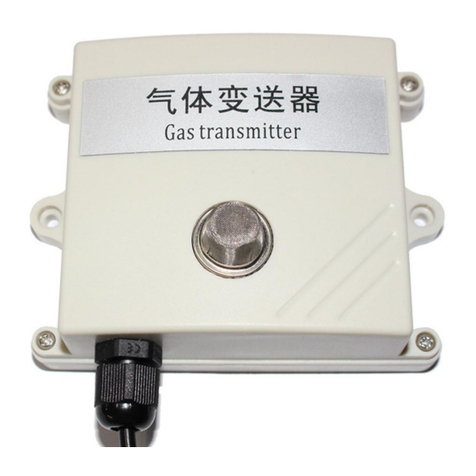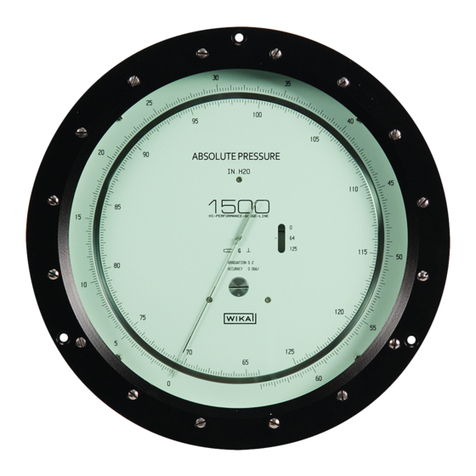Goudsmit HGM09S User manual

O
PERATING
INSTRUCTIONS
GAUSSMETER HGM09S

Gaussmeter HGM09s Operating Instructions
Chapter
Page 2 / 75
© 20 0
© 20 0 © 20 0
© 20 0 Goudsmit Magnetic Systems
Goudsmit Magnetic SystemsGoudsmit Magnetic Systems
Goudsmit Magnetic Systems
All rights reserved. No part of these operating instructions may be reproduced or du-
plicated without the author’s written consent.
We shall not be liable for the accuracy of these operating instructions nor for dam-
ages which can result from the use of this manual. Since mistakes can never be
avoided completely, despite all efforts, we would appreciate any given hint. We will
be anxious to correct any faults known to us as soon as possible.
Edition Note
Data File HGM09_Manual_DE_ _00
Doc. Date 29.06.20 0
Hardware Status VI
Software Status 2903 0
Current Documentation Status .00
Status of Documentation Concerns Page(s) No.
0 /20 0 Compilation

Gaussmeter HGM09s Operating Instructions
Chapter
Page 3 / 75
Tab
TabTab
Table of Contents
le of Contentsle of Contents
le of Contents
Safety Instructions 5
. Safety Instructions for the Device 5
.2 Safety Instructions for the Measuring Probes 6
.3 Safety Symbols 6
2
Brief Introduction 7
2. Preparing a Measurement 7
2.2 Running a Measurement 7
2.3 Measuring Unit 8
2.4 Selecting the Measuring Range 8
2.5 Display 9
2.6 Status Display 9
3
Gaussmeter Function 0
3. The Hall Effect 0
3. .
Linear Properties of the Hall Probe 0
3. .2
Non-linear Properties of the Hall Probe
3.2 Measurement Details 3
3.2.
Sample Measurement with an NdFeB Magnet 3
3.2.2
Remanence and Hall Gaussmeter
Measurement 4
3.2.3
Accuracy Based on Positioning and Direction 5
3.2.4
External Static Magnetic Fields 6
4
Control Elements and Connections 7
4. Front Side Overview 7
4.2 Ports Overview 7
4.3 Power Supply 8
4.4 Batteries 8
4.4.
Charging the Batteries 9
4.5 Probe Connection 20
4.6 USB Interface 20
5
Operation 2
5. Keyboard 2
5.2 Display 22
5.3 Status Display 22
5.4 Switching on/off 24
5.5 Null 24
5.6 Measuring Range 25
5.6.
Overview Measuring Ranges 25
5.7 Measuring Unit 26
5.8 DC/AC Field Measurements 26
5.8.
DC Field Measurements 27
5.8.2
AC Field Measurements 28
5.9 Peak Value Measurement 30
5.9.
Normal Peak Value Recording 30
5.9.2
Fast Peak Value Recording 3
5. 0 Probe Data 33
6
Setup Menu 34
6. Settings 35
6. .
Operating Mode of the USB Interface 35
6. .2
Selecting the Display Units 35
6. .3
Operating Mode of the Peak Value Recording 36
6. .4
DC/AC Field Measurement 36
6. .5
Range Selection 37
6. .6
Polarity Display (North/South) 37
6. .7
Switching off the Device 37
6. .8
Charging the Batteries 38
6. .9
Brightness of Display Illumination 38
6. . 0
Display Contrast Adjustment 38
6. .
Version Remarks 39
7
Serial Interface 40
7. Introduction 40
7.2 Connecting the Gaussmeter to a Computer 4
7.2.
Connector Plug 4
7.3 Direct Operation on the Computer 4
7.3.
Example Normal Measuring Mode in Excel
42
7.3.2
Example Fast Peak Value Mode in Excel
42
7.3.3
Example Slow Peak Value Mode in Excel
42
7.4 Operation via Interface 43
7.4.
Installation on the Computer 43
7.4.2
USB Interface Data Format 43
7.4.3
Character Set 43
7.4.4
Introduction to the SCPI Language 43
7.4.5
SCPI Data Types 45
7.4.6
The SCPI Status Model 48
7.5 Summary of SCPI Commands 5
7.5.
Control Commands 5
7.5.2
Main Commands 5
7.5.3
Peak Value Functions 5
7.5.4
Probe Functions 52
7.5.5
Parameters 52
7.5.6
Device Functions 52
7.6 Explanation of the Individual SCPI Commands 53
7.6.
Control Commands 53
7.6.2
Main Commands 57
7.6.3
Peak Value Function 60
7.6.4
Probe Functions 62
7.6.5
Parameters 63
7.6.6
Device Functions 67
8
Unit Conversion Table 69
9
Technical Data 70
0
Declaration of Conformity 72
Warranty and Copyright 73
2
Index 74

Gaussmeter HGM09s Operating Instructions
Chapter
Page 4 / 75
Table of Illustrations
Table of IllustrationsTable of Illustrations
Table of Illustrations
Display 9
Basic Assembly of a Hall Probe 0
Flux Line Characteristics of NdFeB
Induction Disks 3
Field Strength Pattern of NdFeB
Induction Disk 4
Front Side 7
Ports 7
Battery Box 8
Display 22
USB Connection 4
SCPI Status Model 49

Gaussmeter HGM09s Operating Instructions
Chapter Safety Instructions
Page 5 / 75
Safety Instructions
Safety InstructionsSafety Instructions
Safety Instructions
.
..
. Safety Instructions
Safety InstructionsSafety Instructions
Safety Instructions for the Device
for the Device for the Device
for the Device
Use the measuring instrument only according to the user manual.
Do not replace any parts and do not make any modifications on the product with-
out our explicit and written consent. Do not carry out any service measures at this
device. For repair and maintenance please return the product to Goudsmit Mag-
netic Systems or to your supplier, in order to make sure that all safety features re-
main.
Handling malpractices may result in damage to the device and possibly in injury or
death of persons.
The power supply is designed for a voltage range of 00 to 240VAC at 47 to
63Hz. Do not use the power supply on voltages beyond these areas.
Before use, check the power supply for cracks or missing plastic parts. Pay attention
to the insulation. Do not use the power supply if it is damaged.
Do not dispose of the measuring device in normal household garbage. Please con-
tact the manufacturer for the proper disposal of this instrument.
Only use magnetic field probes designed for this measuring device.
Observe the labeling of this measuring device before connecting a magnetic field
probe to it.
Replace the rechargeable batteries only by batteries of the same type.
Make sure to insert the rechargeable batteries correctly into the measuring device
and mind the correct polarity.
Do not dispose of the rechargeable batteries in the regular household garbage.
Heed your national regulations for the disposal of old batteries.
Do not work in explosive environs or near inflammable gases or vapors with this
device.
Environmental conditions
The device is designed for the use in rooms with low condensation. See technical
data.

Gaussmeter HGM09s Operating Instructions
Chapter Safety Instructions
Page 6 / 75
.2
.2.2
.2 Safety Instructions
Safety InstructionsSafety Instructions
Safety Instructions for the Measur
for the Measur for the Measur
for the Measuring Probes
ing Probesing Probes
ing Probes
The magnetic measurements should only be carried out in areas with a max. vol-
tage of 60V DC, 30V AC RMS. The magnetic field probes are not electrically insu-
lated. Please note that the probe holders and the housing might be electrically con-
nected with the protective earth.
If you work in areas with voltages higher than 60V DC, 30V AC RMS or 42V
peak
values, act with particular caution because of electric shock hazard.
For measurements in high magnetic fields, please pay attention to the dangers that
may arise by strong magnetic fields.
.3
.3.3
.3 Safety
SafetySafety
Safety Symbols
Symbols Symbols
Symbols
Safety symbols can be found on various spots on the device.
Before using this connection or function read the corresponding instructions
in the manual.
This symbol refers to information and references in the instruction manual
which the user has to follow in order to avoid injuries to persons or damage
to the device, or to obtain correct measuring results.

Gaussmeter HGM09s Operating Instructions
Chapter 2 Brief Introduction
Page 7 / 75
2
22
2Brief
BriefBrief
Brief Introduction
Introduction Introduction
Introduction
Measurements with the gaussmeter use the Hall effect as a measuring principle. A
Hall probe is a symmetric semiconductor impressed by current. A magnetic field
running vertically to this element generates an asymmetry on the chip and thereby
creates an output voltage that, as a first approximation, is proportional to the prod-
uct of magnetic field strength and the forced current. For higher magnetic field
strengths this dependency is no more linear. This effect is automatically compen-
sated in the device. The gaussmeter thus measures the magnetic flux density locally.
The sensor only captures the component of the magnetic flux density which runs
perpendicularly through it.
2.
2.2.
2. Preparing a Measurement
Preparing a MeasurementPreparing a Measurement
Preparing a Measurement
•Make sure that the batteries are loaded.
•Connect the device to a personal computer via the USB cable if required. Or
connect the included power supply via the USB socket.
•Connect a measuring probe.
A suitable measuring probe can be plugged in via the Mini-DIN socket on the
top of the device. Each measuring probe is calibrated individually. The calibra-
tion data are stored in the probe memory. On inserting or changing a measur-
ing probe these parameters are read in automatically.
•Switch the device on and off by pressing the I/O
I/OI/O
I/O button longer (approx. 2 sec).
2.2
2.22.2
2.2 Running
RunningRunning
Running a Measurement
a Measurement a Measurement
a Measurement
After switching on the device, the current measuring value is shown continuously.
The display additionally shows further information on the state of the device and the
selected measuring range as well as the measuring mode.
•The measuring range can be changed by pressing the RANGE
RANGERANGE
RANGE button. The
characteristics of this button can be modified in the setup menu. By repeatedly
pressing the RANGE
RANGERANGE
RANGE button both the measuring range and the display unit or
the DC/AC field measurement can be changed.

Gaussmeter HGM09s Operating Instructions
Chapter 2 Brief Introduction
Page 8 / 75
•Insert the measuring probe into the measuring field after adjusting the re-
quested measuring range and the requested unit. Especially for inhomogeneous
magnetic fields, such as they occur on the surface and edges of magnets, keep
in mind that the measured magnetic flux density depends very largely on the
distance and the position. Further pay attention that the magnetic field compo-
nent is measured in one direction only, so that a tilting of the measuring probe
may lead to an error.
2.3
2.32.3
2.3 Measuring Unit
Measuring UnitMeasuring Unit
Measuring Unit
The gaussmeter shows measuring values in physical units of the SI-system as well as
of the CGS system (Gauss system – particularly in use in North America).
The unit is either definitely preset in the setup menu or you can adjust it by pressing
the RANGE
RANGERANGE
RANGE button. Each time you press the button the next unit is selected.
Please note that the same button selects the measuring range and the DC/AC field
measurement, if necessary.
2.4
2.42.4
2.4 Selecting
Selecting Selecting
Selecting the Measuring Range
the Measuring Rangethe Measuring Range
the Measuring Range
By repeatedly pressing the RANGE button, you select the measuring range via four
areas each. The maximum measuring value in this area is shown in the bottom left
area of the display. You can also select an automatic range mode via the setup
menu. In this operating mode, the measuring range is automatically aligned with the
current measurement. Please note that no automatic range adjustment is possible in
the peak mode.
If the measuring value exceeds the selected range limit, the display
shows
-OL-
instead of the measuring value.

Gaussmeter HGM09s Operating Instructions
Chapter 2 Brief Introduction
Page 9 / 75
2.5
2.52.5
2.5 Display
Display Display
Display
A typical example display is demonstrated below.
Figure Display
2.6
2.62.6
2.6 Stat
StatStat
Statu
uu
us
ss
s
Display
DisplayDisplay
Display
In addition to showing the current measuring value, the gaussmeter display also
shows the status information, a negative or positive peak value, if required, and the
state of the USB interface as well as the charging status of the battery.
Unit
Measuring Value
Measuring Range
Operating Mode
Battery St
a
tus
USB St
a
tus

Gaussmeter HGM09s Operating Instructions
Chapter 3 Gaussmeter Function
Page 0 / 75
3
33
3Gaussmeter
GaussmeterGaussmeter
Gaussmeter Function
Function Function
Function
3.
3.3.
3. The Hall Effect
The Hall EffectThe Hall Effect
The Hall Effect
3. .
3. .3. .
3. . Linear Properties of the Hall Probe
Linear Properties of the Hall ProbeLinear Properties of the Hall Probe
Linear Properties of the Hall Probe
The measurement is based on the diflection of charge carriers in a magnetic field in-
side a conductor. For this reason the Lorentz force is the basis for measuring a mag-
netic flux density. If you set a voltage between the beginning and the end of a flat
electrical conductor, the carriers move with a speed of
enDrift
Ev
r
r
⋅=
µ
, whereby
n
µ
represents the carrier mobility in the conductor. Due to their high mobility, the carri-
ers are always electrons. Perpendicular to the current direction, a voltage can be
measured that is ideally proportional to the magnetic flux density. Only the part of
the flux density is effective which runs perpendicularly through the flat side of the con-
ductor.
Figure 2 Basic Assembly of a Hall Probe
If you do not extract any current from the electrodes S and S2, but only measure the
voltage, the following applies:
B
t
w
I
w
U
en
Hall
e
⋅
⋅
=⋅⋅
B
S2 C2
S C

Gaussmeter HGM09s Operating Instructions
Chapter 3 Gaussmeter Function
Page / 75
It follows that:
B
ten
I
U
e
Hall ⋅⋅
⋅
=1
With
This represents the idealized Hall effect.
In reality, the results deviate from this idealized effect.
Since there is a linear equation between the current and the measuring result, it follows
that
BSB
ten
R
e
Hall ⋅=⋅
⋅⋅
=0
1
3. .2
3. .23. .2
3. .2 Non
NonNon
Non-
--
-linear
linear linear
linear Properties
PropertiesProperties
Properties of the Hall Probe
of the Hall Probe of the Hall Probe
of the Hall Probe
Contrary to the idealized description you find a non-linear performance:
(
)
offsetHALLHall
RBBSR +⋅+⋅⋅=
2
0
1
α
For the used Hall probes the real description is true for flux densities of up to approx.
5000 mT.
3. .2.
3. .2.3. .2.
3. .2. Reasons for the Occurrence of R
Reasons for the Occurrence of RReasons for the Occurrence of R
Reasons for the Occurrence of R
offset
offsetoffset
offset
The largest deviation from the idealized Hall effect is the occurrence of an offset volt-
age without a magnetic field. This effect is mainly caused by geometrical asymme-
tries of the Hall element.
e
n
Carrier
e
Elementary charge of the electron ( .6022x 0
- 9
As)
w
Width of the path on which the electrons move
t
Effective force of the Hall element
B
Flux density in [Tesla]

Gaussmeter HGM09s Operating Instructions
Chapter 3 Gaussmeter Function
Page 2 / 75
3. .2.2
3. .2.23. .2.2
3. .2.2 Reasons for the Field Dependenc
Reasons for the Field DependencReasons for the Field Dependenc
Reasons for the Field Dependence
ee
e of the Sensitivity
of the Sensitivity of the Sensitivity
of the Sensitivity
There are several influences for the flux-density dependence of the sensitivity:
The carrier mobility depends on the flux density. This influence generally brings about
a negative α
Hall
and is irrelevant for the used Hall sensors.
More important is the geometry of the used Hall sensors. The lamellar structure cre-
ates a geometry-based field dependence of the sensitivity.
The non-homogeneous distribution of the current density in such a structure is the
cause of this effect.
Already in field-free cases, the current distribution on the Hall element is complex.
This entails a lowering of S
0
and has an influence on the field dependence of the
sensitivity.
A complex real-time correction of the handheld gaussmeter HGM09 compensates for
the inherent non-linearities of the used Hall probes and guarantees a very stable
zero point.
3. .2.3
3. .2.33. .2.3
3. .2.3 Field Dependenc
Field DependencField Dependenc
Field Dependence
ee
e of the Cross Current Resistance
of the Cross Current Resistance of the Cross Current Resistance
of the Cross Current Resistance
The complex current distribution is the cause of the resistance of a Hall probe. Cur-
rent components which, just as the Hall voltage, run perpendicularly to the direction
of the current feed, cause a diverted Hall effect. For the current source this effect re-
sults in a flux density modulated resistor.
The device must have a sufficiently high dynamic for the measurement with fast mag-
netic pulses, to be able to compensate this effect. The handheld gaussmeter HGM09
is optimized for this operating case.
3. .2.4
3. .2.43. .2.4
3. .2.4 Temperature Dependenc
Temperature DependencTemperature Dependenc
Temperature Dependence
ee
e of the Sensitivity
of the Sensitivity of the Sensitivity
of the Sensitivity
Due to the large band gap of the used Hall sensors, the temperature dependence of
the probe sensitivity is low, it is approx. -0.06%/ºC.
3. .2.5
3. .2.53. .2.5
3. .2.5 Temperature Dependenc
Temperature DependencTemperature Dependenc
Temperature Dependence
ee
e of the Cross
of the Cross of the Cross
of the Cross
Current Resistance
Current ResistanceCurrent Resistance
Current Resistance
The temperature dependence of the cross current resistance ranges at approx.
0.3%/ºC and is compensated automatically by the device.

Gaussmeter HGM09s Operating Instructions
Chapter 3 Gaussmeter Function
Page 3 / 75
3.2
3.23.2
3.2 Measurement
MeasurementMeasurement
Measurement D
D D
De
ee
etails
tailstails
tails
The used Hall probes contain a very small active semiconductor area ranging at approx.
00µm. The local resolution of this measuring method is thus rather high. Also note that
individual Hall probes measure one field component only.
3.2.
3.2.3.2.
3.2. Sample
Sample Sample
Sample Measurement
MeasurementMeasurement
Measurement
with
withwith
with a
a a
an
nn
n NdFeB Magnet
NdFeB Magnet NdFeB Magnet
NdFeB Magnet
Due to the high local resolution, the near-surface measurement with magnets may lead
to misinterpretations because of the large field-strength gradients.
Figure 3 Flux Line Characteristics of NdFeB Induction Disks
Figure 3 shows an NdFeB magnet with a material remanence of 400mT. In this exam-
ple the magnetic disk has a thickness of 5mm with a diameter of 20mm. The magnet is
supposed to be measured in mm distance from the surface.

Gaussmeter HGM09s Operating Instructions
Chapter 3 Gaussmeter Function
Page 4 / 75
Figure 4 Field Strength Pattern of NdFeB Induction Disk
The diagram in Figure 4 represents the measurement with a Hall probe which is moved
in parallel to the surface of the magnet with a distance of mm distance to the measur-
ing surface.
A minimum of the flux density emerges in the center of the magnet. Here approx.
230mT are measured. Due to the locally changing working points on the radius of the
magnet, the flux density increases toward the outside. In the center the magnet carries
the highest magnetic load in air and therefore provides the lowest flux density.
3.2.2
3.2.23.2.2
3.2.2 Remanence and Hall Gaussmeter Measurement
Remanence and Hall Gaussmeter MeasurementRemanence and Hall Gaussmeter Measurement
Remanence and Hall Gaussmeter Measurement
The remanence
B
r
is a measure for the aligned magnetic dipoles in the center of the
magnet.
B
r
is the theoretically maximal flux density that can be achieved if the magnet is
in magnetic idle. If it works against a magnetic resistance, it is always
B
<
B
r
.
On the surface of an individual magnet
B
<
B
r
/2 applies even more.
Which value is actually measured in the pole center depends on the geometry of the
magnet.

Gaussmeter HGM09s Operating Instructions
Chapter 3 Gaussmeter Function
Page 5 / 75
As
B
r
as well as
B
are measured in the unit Tesla, the magnetic field measured on the
outside is often mixed up with the remanence.
Please note that a magnet
a magneta magnet
a magnet without back iron only shows a value clearly
shows a value clearlyshows a value clearly
shows a value clearly below the r
below the rbelow the r
below the re-
e-e-
e-
manence
manencemanence
manence on the surface. Due to the local and geometry-dependent measurement, the
remanence of the workpiece cannot be checked reliably with a gaussmeter.
3.2.3
3.2.33.2.3
3.2.3 Accuracy
AccuracyAccuracy
Accuracy Based on
Based on Based on
Based on Positioning and Direction
Positioning and Direction Positioning and Direction
Positioning and Direction
Since the measuring value is dependent on the position, an accurate and repeatable
measurement depends on the exact positioning of the probe during the measurement.
The measurement on the pole center of the magnet is most uncritical. When moving the
probe on the pole surface of the magnet, the measuring value hardly changes at first.
When changing the distance though, the measuring value varies considerably.
The smaller the
The smaller the The smaller the
The smaller the magnet to be measured, the
magnet to be measured, the magnet to be measured, the
magnet to be measured, the stronger eve
stronger evestronger eve
stronger even slight misalignments
n slight misalignments n slight misalignments
n slight misalignments
change the measuring value.
change the measuring value.change the measuring value.
change the measuring value. For quality-related research it is essential to ensure the
positioning accuracy.
Since a Hall probe only records one field strength vector, the correct alignment relative
to the magnet is important.
Please be particularly careful when measuring at the zero point at pole transitions. By
slightly tilting the probe, you measure additional lateral field shares that seem to dis-
place the zero passage.
In normal applications, a maximum flux density value is usually determined at a given
position. The measuring probe is placed in position and varied in location and direction
until the maximum is found. The device supports this measurement with the peak hold.

Gaussmeter HGM09s Operating Instructions
Chapter 3 Gaussmeter Function
Page 6 / 75
3.2.4
3.2.43.2.4
3.2.4 External Static Magnetic Fields
External Static Magnetic Fields External Static Magnetic Fields
External Static Magnetic Fields
Particularly in sensitive measuring ranges, an external static magnetic field, as e.g. the
Earth’s field, can already become clearly noticeable. These external magnetic fields lead
to a corruption of the measuring result.
To compensate external magnetic stray fields or asymmetries of the Hall probe, the de-
vice can be reset.
For this purpose please hold the measuring probe into a field-free area, e.g. a zero
Gauss chamber, or orient the measuring probe in a free field in east-west direction and
press the NULL
NULLNULL
NULL button for approx. 3 seconds. The device then carries out a null balance
automatically.
The values are stored so that this balancing has to be carried out only in seldom cases.
If the magnetic field is too high during the automatic balancing, the correction is stopped
with an error message.

Gaussmeter HGM09s Operating Instructions
Chapter 4 Control Elements and Connections
Page 7 / 75
4
44
4Control Elements and Connections
Control Elements and ConnectionsControl Elements and Connections
Control Elements and Connections
4.
4.4.
4. Front Side Overview
Front Side OverviewFront Side Overview
Front Side Overview
Figure 5 Front Side
4.2
4.24.2
4.2 Ports
PortsPorts
Ports Overview
Overview Overview
Overview
Figure 6 Ports
Display
2 RANGE
RANGERANGE
RANGE button Range selection
3 NULL button Reset
4 DATA
DATADATA
DATA button Data recording
5 IO
IOIO
IO button On/Off
PROBE Port for the probe
2 USB Port for computer or power supply

Gaussmeter HGM09s Operating Instructions
Chapter 4 Control Elements and Connections
Page 8 / 75
4.3
4.34.3
4.3 Power
PowerPower
Power Supply
Supply Supply
Supply
The gaussmeter can be operated with the included power supply. The power supply
is connected via the USB port (type Mini-B) on the top of the device. The power
supply is designed for a line voltage of 00 to 240V alternating current 50-60 hertz
at a charging rate of max. 300mA. Use the power supply only when both the de-
vice itself and the connector cable obviously do not show any damages.
4.4
4.44.4
4.4 Batteries
BatteriesBatteries
Batteries
The device is designed to operate with rechargeable batteries, type NiMH
2450mAh AA PK4. Alternatively the device can also operate with standard NiMH
batteries of the same voltage and similar capacity. Only use the identical battery
type if a change is necessary. Only change both batteries at the same time.
To insert or remove batteries, separate the device from the measuring probe and
remove the cables from the USB plug. Switch off the device. Remove the protective
cover and carefully open the battery box on the bottom side of the device. Mind the
correct inserting position when exchanging the batteries. Mind the correct polarity.
Normally old batteries must not be disposed of in the regular household garbage.
Protect your environment and heed your national waste disposal regulations for old
batteries.
Figure 7 Battery Box
The normal operating time with fully loaded batteries is approx. 0 hours. You can
prolong this time by selecting a darker backlight. You can adjust the brightness in
the parameter menu. Moreover, you can activate the automatic switch-off. The de-
vice switches off automatically after 2 or 5 minutes, if no button is pressed and the
measuring value does not change significantly.

Gaussmeter HGM09s Operating Instructions
Chapter 4 Control Elements and Connections
Page 9 / 75
4.4.
4.4.4.4.
4.4. Charging the Batteries
Charging the BatteriesCharging the Batteries
Charging the Batteries
The battery is charged via the power supply during operation or when connected to
a personal computer. The top right edge of the display shows the battery charge
condition.
Please note that the batteries are only charged when the device is switched on or
when it remains connected to the power supply or personal computer after switch-
ing off. The top right edge of the display shows the battery charging status.
Note
The device does not charge automatically when you feed it via the
power supply and do not switch it on.
You can also avoid the charging by pressing the IO
IOIO
IO button in charging state once
again and hereby finally switch off the device.
In the setup menu you can manually deactivate the battery charging. This might be-
come necessary if your personal computer cannot provide the required charging
current. The interconnection of an active USB hub might help if such a problem oc-
curs. Please note that this hub must however possess its own power supply.

Gaussmeter HGM09s Operating Instructions
Chapter 4 Control Elements and Connections
Page 20 / 75
4.5
4.54.5
4.5 Probe Connection
Probe ConnectionProbe Connection
Probe Connection
The magnetic measuring probe is plugged into the probe port (DIN Mini-DIN-
socket) on the top of the device.
Note
Only use measuring probes which are approved by the manufacturer
to operate with this device.
Note The probe plugs must not be connected to the electric potential, the
protective conductor or the plug shell. If you measure near current
conducting parts, make sure that there is sufficient distance and a suf-
ficiently good insulation.
4.6
4.64.6
4.6 USB Interface
USB InterfaceUSB Interface
USB Interface
The transmission of the measuring values and the entire gaussmeter control
are possible via the installed standard USB interface.
The interface is specified according to the USB (Universal Serial Bus) 2.0.
The interface is not insulated. Please note that the shielding of the measur-
ing probes (e.g. the metallic handle) might be connected to the protective
conductor of your personal computer via this USB interface.
The device supports two USB device classes. On the one hand the HID
class. In this mode the data can be entered directly into any program. The
gaussmeter acts similar to the keyboard of a personal computer.
On the other hand, the device can be operated in the USB device class
CDC and thereby emulates a virtual serial interface on the personal com-
puter or another processor. In contrast to the HID mode, the installation of
a driver on the processor becomes necessary here.
Via the virtual serial interface all functions and parameters of the device
can be set using the SCPI command, and the measuring values can be
read out automatically.
Table of contents
Popular Measuring Instrument manuals by other brands

Blue-White industries
Blue-White industries F-300 installation instructions

Hanna Instruments
Hanna Instruments HI97721 instruction manual

Vaisala
Vaisala MGP261 Installation and safety guide
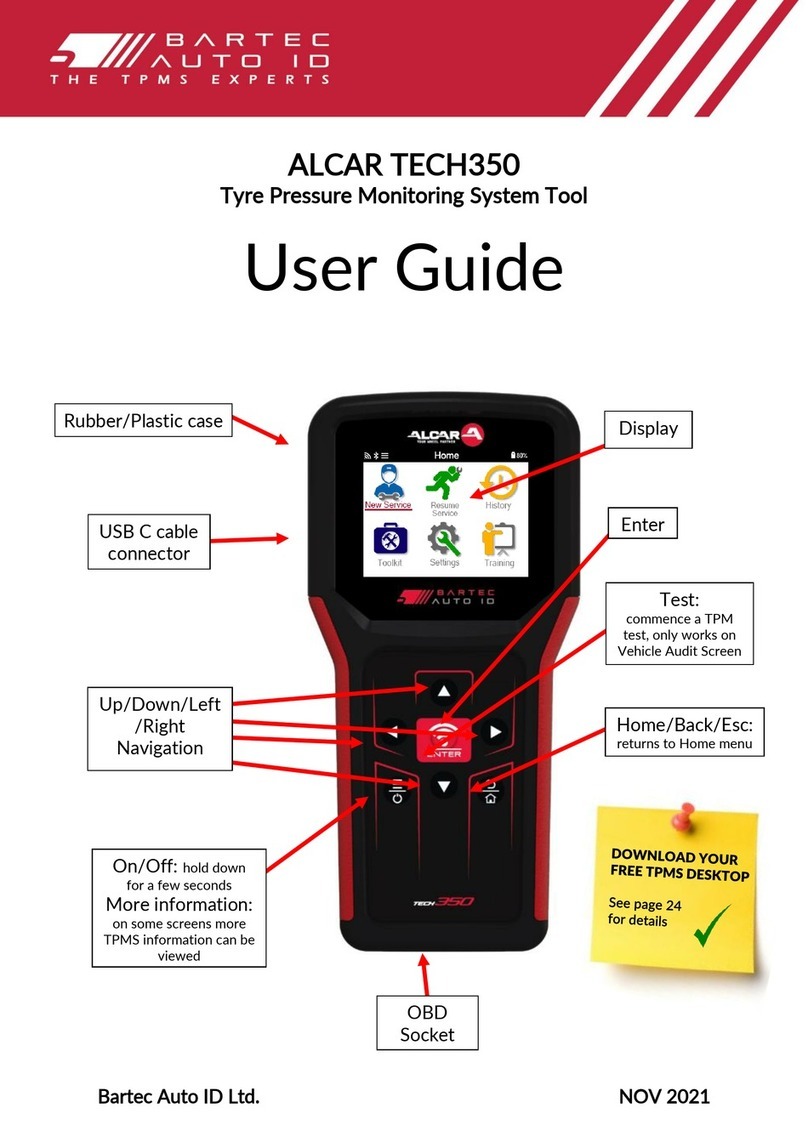
Bartec Auto ID
Bartec Auto ID ALCAR TECH350 user guide
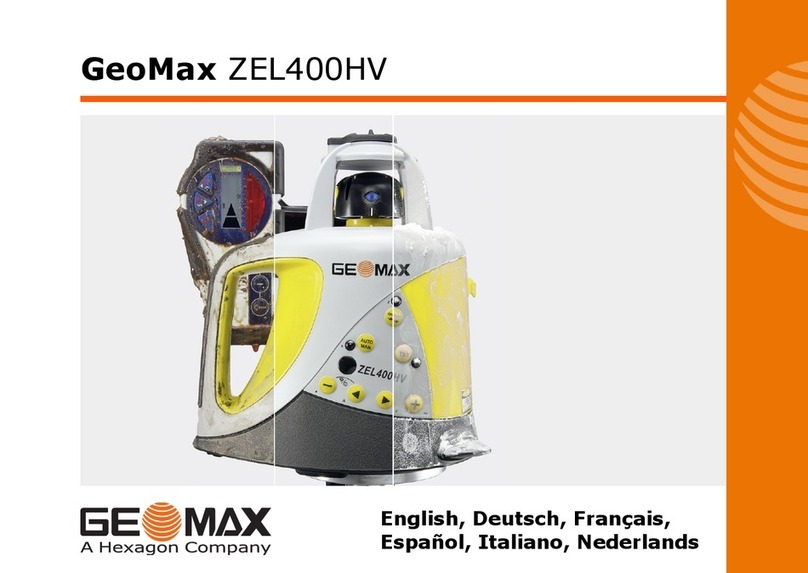
Hexagon
Hexagon GeoMax ZEL400HV user manual
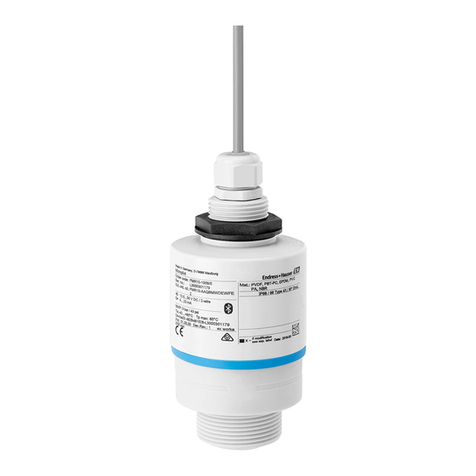
Endress+Hauser
Endress+Hauser Micropilot FMR10 technical information

Peak
Peak MU-Thermocouple1 CAN user manual

BIOLABO Diagnostics
BIOLABO Diagnostics KENZA 240 TX user guide
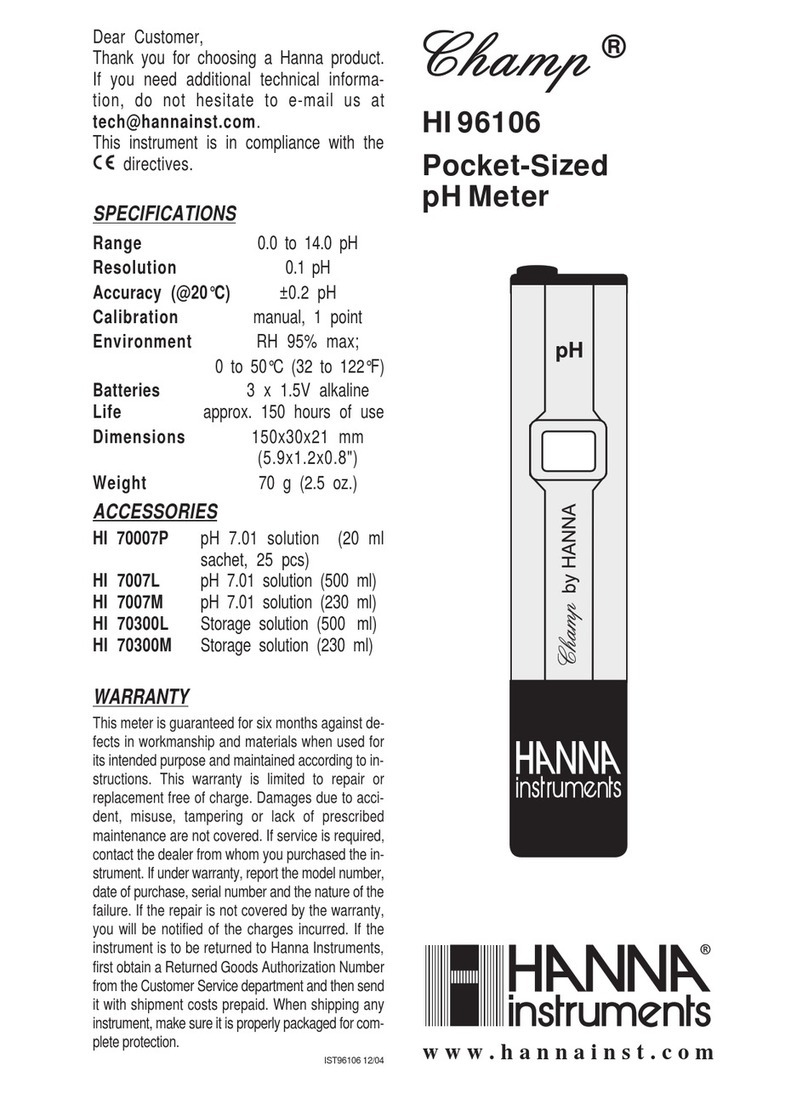
Hanna Instruments
Hanna Instruments Champ HI 96106 instruction manual
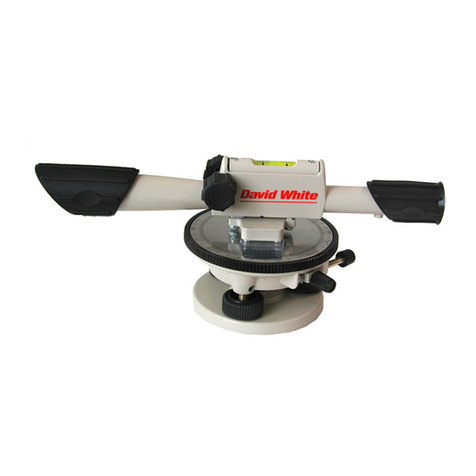
David White
David White L6-20 owner's guide
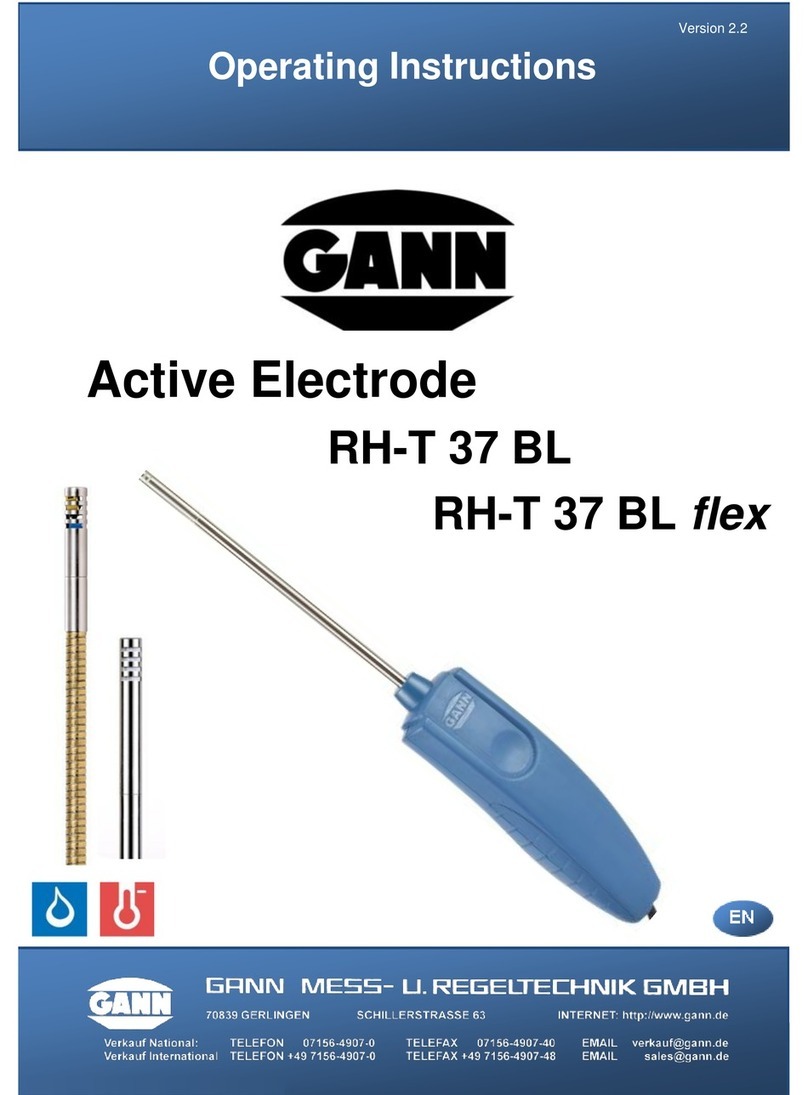
GANN
GANN RH-T 37 BL flex operating instructions

Tohnichi
Tohnichi ATGE-G operating instructions
